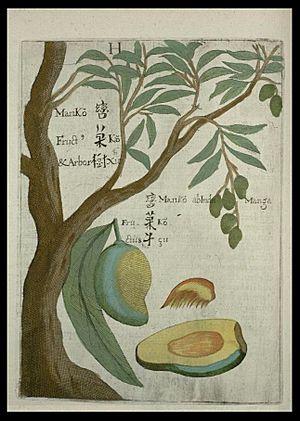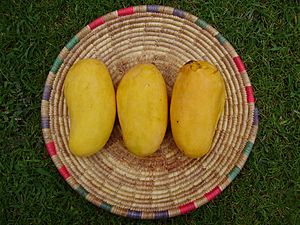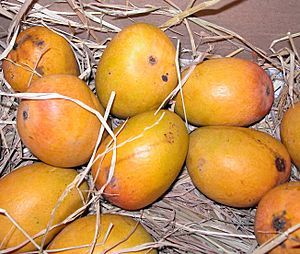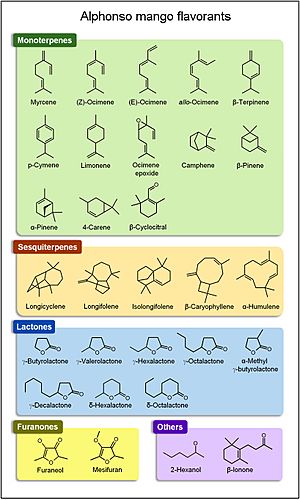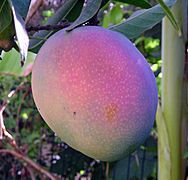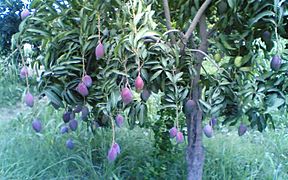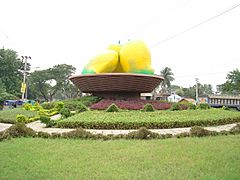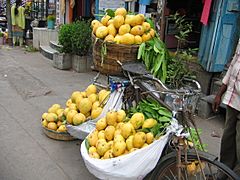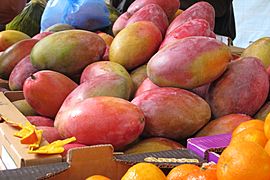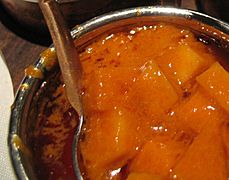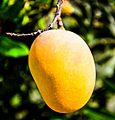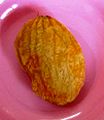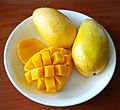Mango facts for kids
Quick facts for kids Mango |
|
|---|---|
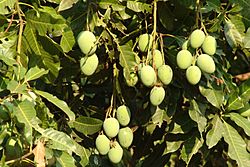 |
|
| Unripe mango fruits | |
| Scientific classification | |
| Kingdom: | |
| Phylum: | |
| Class: | |
| Order: | |
| Family: | |
| Genus: |
Mangifera
|
A mango is a sweet and juicy fruit that grows on trees. It comes from South Asia, a region that includes countries like India and Pakistan. From there, mangoes have spread to many warm, tropical parts of the world. Today, it is one of the most popular fruits grown globally.
Pakistan and India are big exporters of mangoes. The mango is also the national fruit of both countries. Ripe mangoes are very sweet. But before they ripen, they can be quite sour! India has many types of mangoes, like Langra, Dussheri, Chausa, and Alphonso. These different kinds ripen at various times of the year.
Contents
What Does a Mango Tree Look Like?
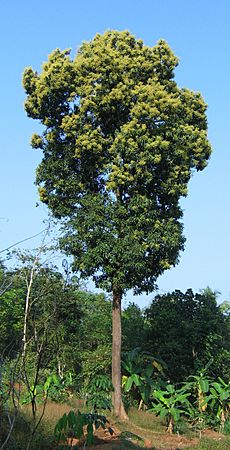
Mango trees are very tall, growing up to 35 to 40 meters (about 115 to 130 feet). Their wide tops can spread out about 10 meters (33 feet). These trees live a long time. Some mango trees still produce fruit after 300 years!
Their main root, called a taproot, can go 6 meters (20 feet) deep into the soil. Many other roots spread out wide and deep too. Mango leaves stay green all year. They are about 15 to 35 cm (6 to 14 inches) long. When new, the leaves are orange-pink, then turn glossy red, and finally dark green.
Mango trees have small, white, sweet-smelling flowers. These flowers grow in big bunches. It takes about four to five months for a mango fruit to ripen after the flowers bloom. There are over 500 known types of mangoes! Most ripen in summer, but some types give fruit twice a year.
The ripe fruit comes in many sizes, shapes, and colors. It can be yellow, orange, red, or green. Inside, each mango has a single flat, long seed. This seed can be a bit stringy or hairy. The skin of a mango is like leather, smooth, and smells sweet. Its color changes from green to yellow, orange, or red when it is fully ripe.
Ripe mangoes have a strong, sweet smell. The seed inside is covered by a thin layer. Mango seeds do not like freezing or drying. Mango trees grow easily from seeds, especially if the seeds come from ripe fruits.
Where Do Mangoes Come From?
The English word "mango" comes from the Malayalam word māṅṅa. Malayalam is a language spoken in South India. Portuguese traders brought the word to Europe in the 15th and 16th centuries.
Mangoes were first mentioned in a book about plants in 1678. When mangoes first arrived in the American colonies in the 1600s, people had to pickle them. This was because there were no refrigerators back then. Other pickled fruits were also called "mangoes." By the 1700s, "to mango" even became a verb meaning "to pickle."
Growing Mangoes Around the World
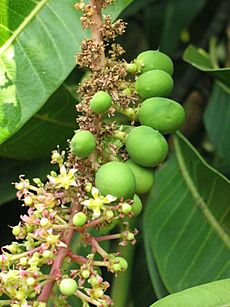
People have been growing mangoes in South Asia for thousands of years. They reached Southeast Asia around 500 to 400 BCE. By the 900s CE, mangoes were being grown in East Africa. Later, they came to places like Brazil, the Caribbean, and Mexico. These places have the right warm climate for mangoes to grow.
Today, mangoes are grown in most warm, tropical, and subtropical areas that don't get frost. Almost half of the world's mangoes come from India. China is the second largest producer. Mangoes are also grown in Spain, especially in the Málaga province. This area has a special coastal climate that allows tropical plants to grow. Other places that grow mangoes include Australia, Pakistan, and Southeast Asia. Even though India grows the most mangoes, it sells less than 1% of them to other countries. India eats most of its own mangoes!
Many types of mango trees are grown by grafting. This means joining a part of one tree to another tree's root system. This helps them grow better. Some mango types are called "dwarf" or "semi-dwarf." These smaller trees can be grown in pots and used as ornamental plants.
Different Kinds of Mangoes
There are hundreds of named mango types, called cultivars. Farmers often grow several types in one area to help with pollination. Many popular types, like 'Alphonso', need to be grown by grafting. 'Alphonso' is a very important mango for export and is often called "the king of mangoes."
A mango type that grows well in one place might not do well in another. For example, the 'Julie' mango grows great in Jamaica. But in Florida, it needs special sprays to fight a plant disease called anthracnose. Mangoes from Asia are naturally strong against this disease.
The 'Tommy Atkins' mango is very popular around the world. It grows a lot, resists diseases, lasts a long time, and looks nice. Even though it's a big success for sellers, many people prefer other types like 'Alphonso' for their taste.
Ripe mangoes usually have an orange-yellow or reddish skin and are juicy. Mangoes sent to other countries are often picked when they are still unripe and green. These mangoes might not be as juicy or flavorful as fresh, ripe ones.
How Many Mangoes Are Grown?
In 2016, the world grew about 46.5 million tonnes of mangoes. This number also includes mangosteens and guavas. India grew the most, with 19 million tonnes, which is 40% of the world's total. China and Thailand were the next biggest growers.
| Mango* production – 2016 | |
|---|---|
| Country | (millions of tonnes) |
|
|
|
|
|
|
|
|
|
|
|
|
|
|
|
|
|
|
|
Source: FAOSTAT of the United Nations |
|
Eating Mangoes
Mangoes are usually sweet. But their taste and texture can be different depending on the type. Some are soft and pulpy, like a very ripe plum. Others are firmer, like a cantaloupe. Some can even be a bit stringy. The skin of unripe, pickled, or cooked mangoes can be eaten. However, some people might get a rash around their mouth from it.
Mangoes in the Kitchen

Mangoes are used in many different dishes around the world. Sour, unripe mangoes are often used to make chutneys or pickles. They can also be eaten raw with salt, chili, or soy sauce. In India, a summer drink called aam panna is made from mangoes.
Mango lassi is a popular drink in South Asia. It's made by mixing ripe mangoes with buttermilk and sugar. Ripe mangoes are also used in curries. Aamras is a thick mango juice, often eaten with flatbreads like chapatis or pooris. Mango pulp can also be made into jam called mangada.
In India, people make chunda (a spicy grated mango dish) and aavakaaya (a pickle from raw mango). Dried mango skin and seeds are used in traditional Ayurvedic medicines. Mango leaves are used to decorate homes during festivals and weddings.
In the Philippines, unripe mangoes are eaten with bagoong (a fermented fish paste). Dried strips of sweet, ripe mango are also popular. Mangoes are used to make juices, smoothies, ice cream, and fruit bars. In Hawaii, mangoes are sometimes charred (lightly burned).
In Central America, green mangoes are eaten with salt, vinegar, black pepper, and hot sauce. Ripe mangoes are used in many sweet dishes. Mango pieces can be mashed and put on ice cream or blended with milk for milkshakes. In Southeast Asia, sweet sticky rice with sliced mango and coconut milk is a popular dessert.
What's Inside a Mango?
| Nutritional value per 100 g (3.5 oz) | |
|---|---|
| Energy | 250 kJ (60 kcal) |
|
15 g
|
|
| Sugars | 13.7 |
| Dietary fiber | 1.6 g |
|
0.38 g
|
|
|
Protein
|
0.82 g
|
| Vitamins | Quantity
%DV†
|
| Vitamin A equiv.
beta-Carotene
lutein zeaxanthin
|
7%
54 μg
6%
640 μg23 μg
|
| Thiamine (B1) |
2%
0.028 mg |
| Riboflavin (B2) |
3%
0.038 mg |
| Niacin (B3) |
4%
0.669 mg |
| Pantothenic acid (B5) |
4%
0.197 mg |
| Vitamin B6 |
9%
0.119 mg |
| Folate (B9) |
11%
43 μg |
| Choline |
2%
7.6 mg |
| Vitamin C |
44%
36.4 mg |
| Vitamin E |
6%
0.9 mg |
| Vitamin K |
4%
4.2 μg |
| Minerals | Quantity
%DV†
|
| Calcium |
1%
11 mg |
| Iron |
1%
0.16 mg |
| Magnesium |
3%
10 mg |
| Manganese |
3%
0.063 mg |
| Phosphorus |
2%
14 mg |
| Potassium |
6%
168 mg |
| Sodium |
0%
1 mg |
| Zinc |
1%
0.09 mg |
| †Percentages estimated using US recommendations for adults. | |
Nutrients
A 100-gram (3.5-ounce) serving of mango has about 250 kJ (60 calories). Fresh mangoes have many nutrients. They are especially rich in vitamin C and folate. These are important for your body to stay healthy.
Natural Chemicals
Mango peel and fruit pulp contain many natural chemicals. These include carotenoids, which give mangoes their yellow-orange color. Beta-carotene, a type of carotenoid, turns into provitamin A in your body. Mangoes also have polyphenols, like quercetin and gallic acid. These chemicals are being studied for their possible health benefits.
The Taste of Mangoes
The amazing flavor of mangoes comes from several natural chemicals. These chemicals belong to groups like terpenes, furanones, lactones, and esters. Different types of mangoes can have different amounts of these chemicals, which changes their taste.
For example, mangoes from the "New World" (like the Americas) often taste like a chemical called δ-3-carene. Mangoes from the "Old World" (like Asia) have more of other chemicals, including lactones and furanones. The 'Alphonso' mango from India is very popular. Its special taste comes from lactones and furanones that develop as the fruit ripens.
Mangoes in Culture

The mango is the national fruit of India, Pakistan, and the Philippines. It is also the national tree of Bangladesh. In India, the mango harvest season is from March to May. This is a big event that news channels often cover.
The Mughal emperor Akbar (who ruled from 1556 to 1605) is said to have planted a huge mango orchard with 100,000 trees in India. In the Jain religion, the goddess Ambika is often shown sitting under a mango tree. In Hinduism, the god Ganesha sometimes holds a ripe mango. This symbolizes reaching perfection. Mango blossoms are also used to worship the goddess Saraswati.
In India, mango leaves are thought to bring good luck. People use them to decorate doorways during festivals and weddings. Mango patterns, like the paisley, are very common in Indian embroidery. You can see them on beautiful shawls and silk sarees.
In Tamil Nadu, a state in India, the mango is one of three "royal fruits." The other two are the banana and jackfruit. They are loved for their sweetness and flavor.
Mango drinks are very popular in India. Brands like Frooti, Maaza, and Slice are well-known. In Australia, the first tray of mangoes of the season is traditionally sold at an auction to raise money for charity.
During the Cultural Revolution in China, mangoes became a symbol of Chairman Mao Zedong's love for the people. This made mangoes very popular, even though they were almost unknown there before.
Gallery
-
A nearly ripened purple mango, Israel
-
Shan-e-Khuda, a mango grown in Pakistan
-
Mango roundabout, Rajshahi
-
Mango chutney
Images for kids
-
'Carabao', a typical "Southeast Asian type" polyembryonic mango cultivar
-
Unripe mangos in Rincón, Puerto Rico
See also
 In Spanish: Mango para niños
In Spanish: Mango para niños


